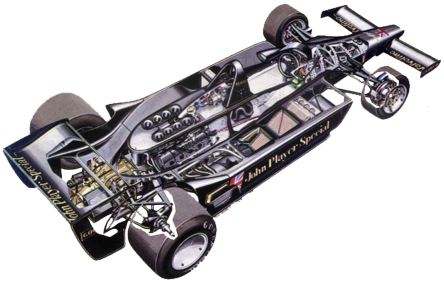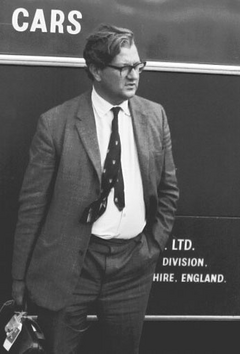Well, 2010 is almost finished, cold weather has spread over Europe and hopefully we have all been good little children and Santa Claus has been kind (he brought me a new DSLR and zoom lens) all the better to record ‘Design Error of the Month’
This month, as a special gift and something different, I am offering you a Design Internal Memo from Lotus F1 in 1976. It was penned by Tony Rudd who was then the Chief Engineer at Lotus and contains many pearls of wisdom. It is a collection of design requirements in the Design Office at Lotus.
Some of the content is not very relevant to FSG but most is. Rudd’s phraseology is sometimes difficult to understand and some of his statements may be a source of debate. That is good.
You may have read this before as it has been published over the years in several places, but I came across it again during my Christmas reading and decided to pass it on. Please enjoy.
Meanwhile I wish you all the very best of luck in your endeavours in 2011 and look forward to seeing many of you at various competitions this Northern Summer.

In the 1976, Tony Rudd was the Chief engineer at the Lotus F1 team.
Lotus were in the doldrums following a series of World Championship wins in the 1960s and founder Colin Chapman tasked Rudd with steering the team back to success.
One of Rudd’s tactics was to write a series of ‘rules’ to be distributed to all staff at lotus.
This document is as valid today as it was in 1976 so I will repeat it here for the benefit of all.
Lotus returned to be World Champion again in 1978!
Tony Rudd died in 2003.

SURVIVAL RULES (YOURS AND THE DRIVERS)
- The keywords are elegant simplicity. Each part doing three jobs at least.
- The objective is to win the race. Remember, the car has to finish and a tired, blistered driver won’t help.
- Car must be designed so that a pre-race check can be carried out completely by one man in six hours. Rectification or readjustment is extra.
- Pre-race check sheet is supplied to the operator. With each new type of sheet, operators will add to, but may nor delete from this. Designer starts the sheet, build and development will add to it and engineering director signs it into law.
- (Anti)-roll bar, camber, wing, brake balance bar changes must be possible in five minutes and repeatable. These are no good if they cannot be identified and repeated. Avoid infinite variable screwed adjustment.
- Murphy is a racing mechanic and works for Team Lotus. If it can be assembled the wrong way around he will.
- Never design or cause to be made something that cannot be inspected. Again, never design something that cannot be seen to be safe or that needs special equipment to prove it.
- All spherical bearings need protective covers.
- You can’t change people, so make the car easy to adjust and maintain by easy access.
- A grease seal over a universal near a brake disk is better than none at all. It will fail before it gets renewed so provide a finger disk to direct the grease clear of the brake.
- Stress suspension for a 3g bump on a 2g corner.
- If the driver believes the car is strong enough it’s worth more than one second a lap. Avoid birdcage structures. All tubular structures to be 3-inch circumference. Adjust the gauge for load.
- Never use banjos on the pressure side of the fuel system.
- Never use ‘O’ rings to seal negative pressure.
- All material, including human skin, are notch sensitive – some more than others – so use appropriate radii.
- Remember, all engineering materials are rubber like. They deflect to some degree under the slightest load and will expand to some degree in the presence of even a lighted match. Everything resonates, even brake pipes.
- All flexible fuel and oil lines are to have screwed ends and armoured flexibles.
- Drivers feel corners through the seat of their pants, their heels and above all, under their armpits. Ensure seat back is 100% rigid and fits.
- Gearchange linkages wear, bend and stretch. Provide 100% over-travel clearances in all directions.
- Provide throttle pedal stop at the pedal and the return spring at the throttle slides, preferably in compression so it still works when broken.
- Remember, a frantic driver can put 250lb (113kg) on a pedal or a gearlever.
- Do not try to exceed 20ft (6.1m) per second in a water pipe, you won’t. Neither can you exceed 12ft (3.7m) per second for 30/30 oil.
- 90-degree welded bends, i.e. 45-degree scarf joints, reduce flow by 5% even if you remove internal nuggets. Double cut and shut ie 2 x 22.5-degrees, cost 2% and a 4D radius just ½%.
- Always specify the size of ball you must be able to roll down a pipe system to ensure adequate flow.
- Providing oil and fuel tank dipsticks may prevent a lost race through inaccurate consumption checks.
- Wheel deflections, camber changes and toe steer required during the no spring bump test must be specified on suspension data sheets by designer and countersigned by him when he has seen the test, and a photocopy put into the cars log book.
- Car acceptance test includes proving that the fuel system draws down to one pint (.6 litre) from five gallons (21 litres) whilst running at least at 90% of the test circuit record time.
- Don’t invent new oil tanks, use the ones proved to work. Remember the fluid that comes out of the oil coolers may look like oil, but it contains 25% by volume of air at least.
- Air leaks at the suction side of the oil pump destroy one engine per race. Keep Duckworth poor.
- Brakes recuperate better with a head of fluid above the master cylinder. Low mount the cylinder with a a high separate reservoir, with a big enough pipe. And don’t forget the scent spray. Always pressure bleed.
- Air in motion is the best heat insulator.
- If the airbox is working, there is a load of 150lb inside it and it will bulge or blow off if insecurely fastened. If insecurely fastened and it doesn’t blow off, it doesn’t work.
- You cannot change the basic laws of nature, no one has yet. Let Newton, Charles, Boyle, Bramah and Bernoulli rest in peace.
- Lightening holes should be the last resort of the designer. The most effective way of weight saving is not to start with it.
- Measured over the wheelbase, one axle restrained and lifting one corner of the opposite axle, torsional stiffness of the entire structure must exceed 2,500ft.lbs (3456Nm) per degree. The variation in stiffness per foot of wheelbase must not exceed +/- 10% or 15% between two adjacent sections otherwise fatigue failures are likely.
- Keep suction lines as short and straight and simple as possible: no rubber elbows at pump inlets.
- If there is no other way to join two components together than with bolts, remember they work by stretching between .003” and .005” per inch of length. Make sure they can do, even if you have to provide a waisted section to keep the local stretching near the elastic limit of the material. 3% nickel is best.
- Although titanium is 70% the weight and 1000% the cost of high-grade steel, it is 50% more resilient and 1000% more gall sensitive. Use it with care, after you have assessed maraging steel, which strength for strength is also 70% the weight of high-grade steel, 200% the price and just as rigid.
- Corner weight tolerances +/- 2%. Enter in the cars log book.
- The deflection of the lowest part of the wheel rim, relative to the tub centreline should not exceed the static corner weight/2000” (CW/50.8M) when 1g cornering load is applied. Neither should the camber change by more than 20 degrees during this test.
- All systems must be flow tested before the car is started. Flows required must be marked on the system’s drawings. A bucket and stopwatch is quick and accurate e.g. Fuel system must flow 250 pints/hour with 100psi pressure.
- Keep a pair of every drivers driving shoes or sole patterns, suitably labelled, in the Design Office.
- Remember cars will run with transducers on suspension travel, throttle slides, strain gauges on wishbones and wing mountings and ‘black boxes with invertors’. Bear this in mind without compromising design.
- Always weigh the car before and after paint, including signwriting. Weight increase not to exceed .05%.
- Racing cars get out of line. Always provide and prove 30 degrees of lock so drivers can get them back. Saves one shunt per year.
- Always measure spring frequencies against specifications after no spring bump tests. Designer enters results in log book.
- All log book entries signed legibly and dated.
- Operations will not accept, neither will we offer them a car without a log book, which will show no spring bump tests, toe curves, corner weights, flow tests, tilt rig test results and contains data sheets. Losing the log book is a capital offence.
Signed
Tony Rudd


